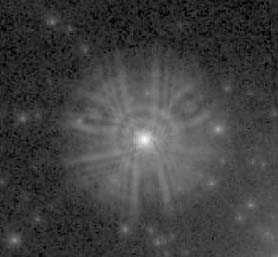Resolving Stars in 30 Doradus
The Melnick 34 region viewed by:
![]() The HST's Wide Field Planetary Camera 2
The HST's Wide Field Planetary Camera 2
![]() The original Wide Field Planetary Camera
The original Wide Field Planetary Camera
![]() The European Southern Observatory
The European Southern Observatory
![]() The Human Eye
The Human Eye
The Hubble Telescope was sent aloft with an incorrectly figured primary mirror that formed out-of-focus images. Although Melnick 34 and many of the stars around it are visible, the effect of the faulty optics shows as blurred skirts of light spreading out from star images. The light from the fainter stars is lost altogether in the scattered light of the image.
Note: The fault in the main mirror was corrected when a new Wide Field Planetary Camera was installed during the telescope's first servicing mission.

 The Melnick 34 field above is only a third of a minute across - one hundredth the
diameter of the moon. (The arrow indicates a similar sized region on the Moon).
The Melnick 34 field above is only a third of a minute across - one hundredth the
diameter of the moon. (The arrow indicates a similar sized region on the Moon).